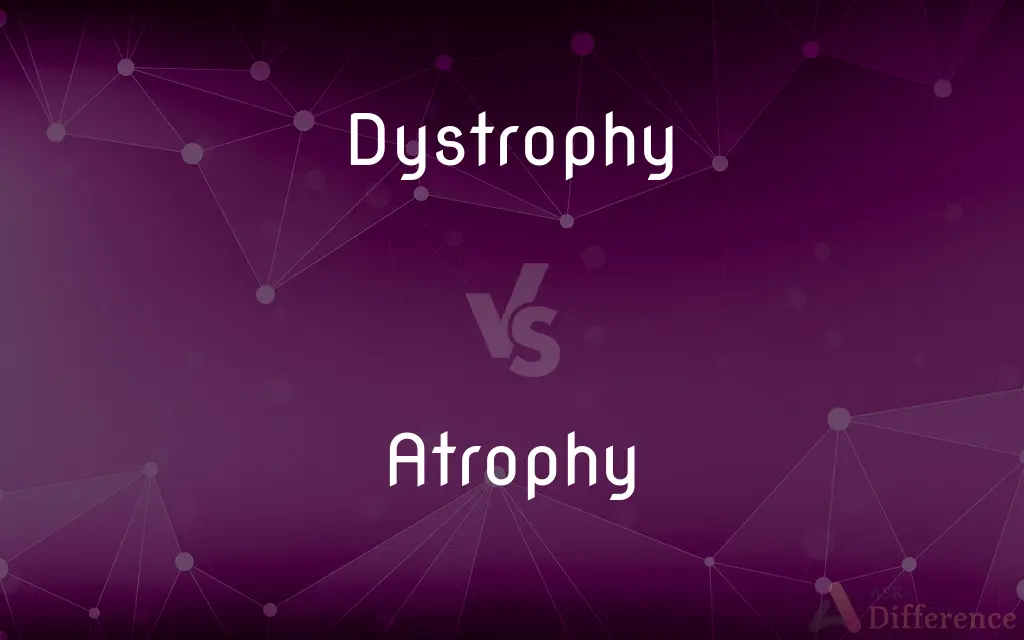Dystrophy vs. Atrophy — What's the Difference?
Edited by Tayyaba Rehman — By Fiza Rafique — Updated on October 5, 2023
Dystrophy refers to abnormal development or growth, often due to genetic mutations. Atrophy describes a decrease in size or wasting away of a body part, typically due to underuse or disease.

Difference Between Dystrophy and Atrophy
Table of Contents
ADVERTISEMENT
Key Differences
Dystrophy and atrophy are both medical terms related to tissue or muscle abnormalities. Dystrophy typically refers to diseases where genetic mutations cause abnormal development or growth of tissue, muscle, or bone. Atrophy, on the other hand, pertains to a decrease in size or the wasting away of a body part or tissue, usually because of a lack of use, nerve damage, or disease conditions.
In the context of muscle, muscular dystrophies are a group of genetic disorders that result in progressive muscle weakness and loss. These disorders are typically inherited and can vary in terms of onset and severity. Muscular atrophy, however, means the muscles are shrinking or wasting away, either because they're not being used (like when a limb is in a cast) or because of a medical condition that affects muscle strength.
Dystrophic changes in the body can occur in various forms, such as in dystrophic calcification where abnormal calcium deposits form in tissues. Atrophy, meanwhile, can be seen in conditions like Alzheimer's disease where there's a noticeable reduction in brain tissue over time.
One notable distinction is that dystrophy often has a genetic component to its origin, meaning it's passed down through families. Atrophy, while it can be a result of a genetic disorder, often arises from external factors like immobility, malnutrition, or nerve damage.
In summary, while both dystrophy and atrophy relate to disorders or changes in tissues or muscles, they have distinct causes and manifestations.
ADVERTISEMENT
Comparison Chart
Definition
Abnormal development or growth.
Decrease in size or wasting away.
Typical Causes
Genetic mutations, inherited disorders.
Lack of use, disease, nerve damage.
Example Conditions
Muscular dystrophy, dystrophic calcification.
Muscle atrophy, brain atrophy.
Onset
Can be present from birth or develop over time.
Typically develops over time.
Genetic Component
Often has a genetic component.
Can be due to genetics or external factors.
Compare with Definitions
Dystrophy
A disorder involving abnormal growth or development.
Muscular dystrophy affects muscle strength and mobility.
Atrophy
A medical term for the wasting away of body parts.
Spinal muscular atrophy affects the motor nerve cells in the spinal cord.
Dystrophy
A medical term for any condition with abnormal organ or tissue development.
Nail dystrophy can be a sign of underlying health issues.
Atrophy
The decline or reduction in size of an organ or tissue.
The prolonged bed rest led to muscle atrophy in his legs.
Dystrophy
A condition caused by genetic mutations leading to tissue abnormalities.
Due to corneal dystrophy, her vision was slowly deteriorating.
Atrophy
The degeneration or shrinkage of body parts, typically from disuse.
Astronauts can experience muscle and bone atrophy in space due to the weightless environment.
Dystrophy
Abnormalities in body structures often due to genetic factors.
Retinal dystrophy impairs the functioning of the retina in the eye.
Atrophy
A condition characterized by diminished tissue size or function.
Brain atrophy in Alzheimer's patients can be detected through MRI scans.
Dystrophy
Dystrophy is the degeneration of tissue, due to disease or malnutrition, most likely due to heredity.
Atrophy
Atrophy is the partial or complete wasting away of a part of the body. Causes of atrophy include mutations (which can destroy the gene to build up the organ), poor nourishment, poor circulation, loss of hormonal support, loss of nerve supply to the target organ, excessive amount of apoptosis of cells, and disuse or lack of exercise or disease intrinsic to the tissue itself.
Dystrophy
Any of various unrelated, noninfectious, often genetic disorders characterized by progressive deterioration or structural alteration of a body part.
Atrophy
A wasting or decrease in size of a body organ, tissue, or part owing to disease, injury, or lack of use
Muscular atrophy of a person affected with paralysis.
Dystrophy
A degenerative disorder caused by inadequate or defective nutrition. No longer in scientific use.
Atrophy
A wasting away, deterioration, or diminution
Intellectual atrophy.
Dystrophy
(Ecology) The condition of being dystrophic.
Atrophy
To cause to wither or deteriorate; affect with atrophy.
Dystrophy
A wasting of body tissues, of either genetic origin or due to inadequate or defective nutrition.
Atrophy
To waste away; wither or deteriorate.
Dystrophy
Any of several hereditary diseases of the muscular system characterized by weakness and wasting of skeletal muscles
Atrophy
(pathology) A reduction in the functionality of an organ caused by disease, injury or lack of use.
Dystrophy
Any degenerative disorder resulting from inadequate or faulty nutrition
Atrophy
(intransitive) To wither or waste away.
Dystrophy
An inherited disorder causing progressive tissue degeneration.
Duchenne muscular dystrophy is one of the most severe forms of this disease.
Atrophy
(transitive) To cause to waste away or become abortive; to starve or weaken.
Atrophy
A wasting away from lack of nourishment; diminution in bulk or slow emaciation of the body or of any part.
Atrophy
To cause to waste away or become abortive; to starve or weaken.
Atrophy
To waste away; to dwindle.
Atrophy
A decrease in size of an organ caused by disease or disuse
Atrophy
Any weakening or degeneration (especially through lack of use)
Atrophy
Undergo atrophy;
Muscles that are not used will atrophy
Atrophy
A decrease in size or functionality due to underuse or disease.
After her injury, she experienced significant muscle atrophy from lack of movement.
Common Curiosities
Can both conditions be genetic?
Dystrophy often has a genetic component, whereas atrophy can result from genetics or external factors.
Can atrophy be a result of dystrophy?
Yes, for example, in muscular dystrophy, the muscles can undergo atrophy due to the underlying genetic condition.
Are both dystrophy and atrophy reversible?
It depends on the cause. Some forms of atrophy (like from disuse) can be reversible with therapy, while many forms of dystrophy, being genetic, are not reversible.
Can aging lead to atrophy?
Yes, aging can lead to various forms of atrophy, such as brain or muscle atrophy.
How is atrophy different from dystrophy?
Atrophy describes the decrease in size or wasting away of a body part, typically due to underuse or disease, while dystrophy pertains to abnormal development or growth.
What is dystrophy?
Dystrophy refers to abnormal development or growth, often due to genetic mutations.
Is muscular dystrophy a type of muscle atrophy?
Muscular dystrophy is a genetic disorder that can result in muscle atrophy, but they're not the same thing.
Can both dystrophy and atrophy affect organs other than muscles?
Yes, they can affect various organs and tissues, like the brain, retina, nails, etc.
Are dystrophy and atrophy always pathological?
Most often, they indicate underlying health issues, but some atrophy (like from aging) is a natural process.
How can one prevent muscle atrophy?
Regular exercise, a balanced diet, and avoiding prolonged immobility can help prevent muscle atrophy.
Can injury lead to atrophy?
Yes, if an injury leads to prolonged immobility or nerve damage, it can cause muscle atrophy.
Are there treatments available for dystrophy?
Treatments for dystrophy vary based on the type and severity, and they often aim to manage symptoms rather than cure the condition.
Is dystrophy always present from birth?
Not necessarily. Some forms can be present from birth, while others develop later in life.
Is physical therapy beneficial for both conditions?
Physical therapy can help manage symptoms, improve function, and slow progression in many cases of dystrophy and atrophy.c
Are there early signs to detect dystrophy or atrophy?
Symptoms vary based on the type and location but can include weakness, reduced function, or visible size reduction.
Share Your Discovery

Previous Comparison
Opera vs. Oratorio
Next Comparison
Confidante vs. ConfidantAuthor Spotlight
Written by
Fiza RafiqueFiza Rafique is a skilled content writer at AskDifference.com, where she meticulously refines and enhances written pieces. Drawing from her vast editorial expertise, Fiza ensures clarity, accuracy, and precision in every article. Passionate about language, she continually seeks to elevate the quality of content for readers worldwide.
Edited by
Tayyaba RehmanTayyaba Rehman is a distinguished writer, currently serving as a primary contributor to askdifference.com. As a researcher in semantics and etymology, Tayyaba's passion for the complexity of languages and their distinctions has found a perfect home on the platform. Tayyaba delves into the intricacies of language, distinguishing between commonly confused words and phrases, thereby providing clarity for readers worldwide.
















































